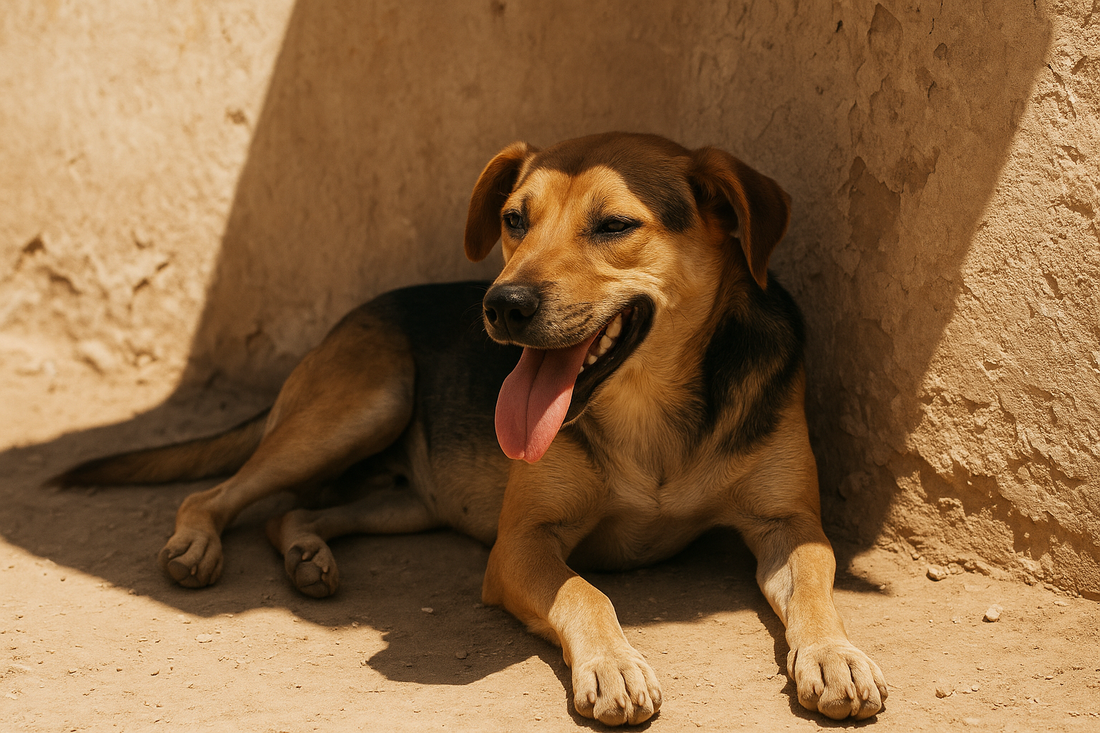
Dog Dehydration & Heatstroke: Signs, Safe Walking Temperatures, and Summer Safety Tips
Share
How to walk your dog safely in high temperatures
Warm weather means more adventures outdoors, but it also brings a serious risk to our furry friends: dehydration and heatstroke. Dogs can’t cool down as efficiently as humans do, making them especially vulnerable to heat-related illnesses. Knowing the warning signs—and when it’s too hot for a walk—could save your dog’s life.
Why Dogs Overheat More Easily
Dogs regulate their body temperature mainly through panting and a small amount of sweating through their paw pads. When temperatures rise—or if they exercise too much in the heat—their cooling system can get overwhelmed quickly. Breeds with flat faces (like Bulldogs and Pugs), puppies, seniors, and overweight dogs are at even higher risk.
Temperature Guide: When It’s Safe to Walk Your Dog
Dogs feel heat more intensely than humans, especially through their paw pads on hot pavement. Use this guide to help decide when it’s safe:
🌡️ Below 68°F (20°C):
Safe for most dogs. Perfect walking conditions.
🌡️ 68–77°F (20–25°C):
Generally safe, but watch high-energy or flat-faced breeds. Take water and avoid overly strenuous activity.
🌡️ 78–86°F (26–30°C):
Caution zone. Walks should be shorter, slower, and ideally in shaded areas. Pavement may be hot—use the “hand test”: if you can’t hold your palm on the ground for 5 seconds, it’s too hot for paws.
🌡️ 87–95°F (31–35°C):
High risk of overheating. Limit walks to very early morning or late evening when it’s cooler. Stick to grass instead of pavement.
🌡️ 95°F (35°C) and above:
Danger zone. It’s too hot for safe walks. Stick to indoor play, shaded rest, and plenty of water.
Humidity matters: Even at “moderate” temperatures, high humidity makes it harder for dogs to cool themselves.
Pavement Heat Danger: How Hot Is Too Hot?
One of the biggest hidden risks isn’t just the air—it’s the ground beneath your dog’s paws. Asphalt, concrete, and sand absorb heat and can burn sensitive paw pads quickly.
Here’s how hot pavement can get compared to the air temperature:
|
Air Temperature |
Approx. Pavement Temperature |
Risk to Dog’s Paws |
|
77°F (25°C) |
125°F (52°C) |
Skin damage possible in under 60 seconds |
|
86°F (30°C) |
135°F (57°C) |
Burns in less than 60 seconds |
|
95°F (35°C) |
145°F (63°C) |
Severe burns almost instantly |
|
104°F (40°C) |
155°F (68°C) |
Instant paw pad damage |
To test if the pavement is safe: Place the back of your hand on it for 5 seconds. If it’s too hot for your skin, it’s too hot for your dog’s paws.
Signs of Dehydration in Dogs
Dehydration occurs when a dog loses more fluids than they take in. Watch for these early warning signs:
- Dry gums and nose – Healthy gums should feel moist; tacky or sticky gums are a red flag.
- Sunken eyes – Eyes may appear dull or recessed.
- Loss of skin elasticity – Gently pinch the skin at the back of the neck; if it doesn’t snap back quickly, your dog may be dehydrated.
- Lethargy – A dehydrated dog may seem weak, sluggish, or less interested in play.
- Excessive panting – While panting is normal, it may become more pronounced if fluids are low.
Signs of Heatstroke in Dogs
Heatstroke is a life-threatening emergency where a dog’s body temperature rises dangerously high. Symptoms include:
- Excessive, rapid panting – Breathing may be strained or noisy.
- Bright red or pale gums and tongue – A sign of poor circulation.
- Drooling or thick, sticky saliva – Heat stress makes it harder for dogs to swallow.
- Vomiting or diarrhea – Sometimes with blood.
- Disorientation or collapse – Stumbling, confusion, or loss of consciousness are late-stage warning signs.
- Seizures – In severe cases, the nervous system is affected.
What to Do If You Suspect Heatstroke
- Move your dog to a cooler place immediately – Indoors with air conditioning or in the shade.
- Offer small amounts of cool (not ice-cold) water – Don’t let them gulp too much at once.
- Cool their body gradually – Start by using lukewarm water on the belly, paws, and armpits, or get them to lie down on a damp towel. Avoid ice baths, which can constrict blood vessels and trap heat. Also, avoid wetting the fur on your dogs back, which can limit their ability to naturally shed heat.
- Seek veterinary help right away – Even if your dog seems to recover, internal damage can occur. Heatstroke is always a medical emergency.
Preventing Dehydration and Heatstroke
- Always carry fresh water on walks.
- Walk early in the morning or late in the evening during summer.
- Stick to grass or shaded areas.
- Never leave your dog in a parked car, even for a few minutes.
- Use cooling mats, fans, or dog-safe vests on very warm days.
- Avoid walks altogether if the risk is too high
Final Thoughts
Dehydration and heatstroke can progress quickly, but with vigilance, prevention, and fast action, you can keep your dog safe in the summer heat. Pay attention to both the air temperature and the ground temperature, and always err on the side of caution—your pup’s health and happiness depend on it.
